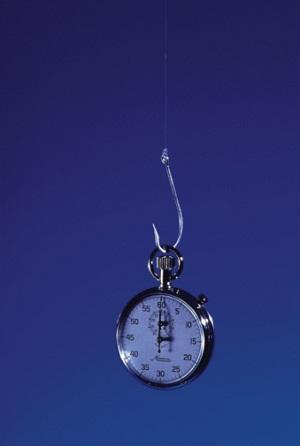
Arguably the most important part of any presentation is the beginning. It sets the foundation for the rest of your talk. If you come across as a strong, entertaining speaker at the beginning of your presentation, people will be forgiving if your material gets a little more routine as the talk progresses. Most peoples’ judgment is reserved for those first few seconds of the talk. So if you want to get people listening you need to hook them fast.
Think about it. How many times have you heard a speech that begins with, “I’m here to talk with you today about….” Or “Thanks for coming out to listen to my talk about…” or some variation of these intros. While they do get straight to the point, they do absolutely nothing to grab your audience, to rivet them so they’ll listen, or in other words hook them. With that in mind, here are a few ways to get your audience’s attention right off the bat.
Quote, Anecdote, Rhetorical Question
These are some of the most common ways to hook your audience. You must be sure to use a quote, anecdote, or rhetorical question that segues nicely into your material. If, for example, you were talking about the current recession, you could give an anecdote about the Great Depression and use it to underlie the point of your message. Or you could ask the rhetorical question: Just how similar is our current economic crisis to that of the 1930s? These types of lead ins will get people wondering, and help them tune in to what it is you’re saying.
New Twist on the Familiar
Take a common story, quote, saying, or anecdote and change it. This will give your audience a new perspective on the familiar as well as grab their attention. If you handle the twist skillfully enough, you can actually make quite an impression. Let’s say you were giving a presentation on nutrition in America. You could say something like, “To eat, or not to eat. That is the question.” The bolder the twist, the better the reaction will be. However, you must make sure it makes sense and fits into your material. One of the best ways is to simply find popular aphorisms online and try switching the wording around.
Personal Story
This will help introduce you as a speaker and gives a personal take on the material. Part of what gives you credibility as a speaker is the authority you have to talk about a subject. A good way to do this, for example, could be to lead into your presentation with a personal story about how you got involved in the field, started your business, or became an expert on the subject. The key is to be either funny or endearing so people will trust you.
Audience Participation Exercise
This is useful as an icebreaker, but typically only works in small settings. The simplest example is to have everyone introduce themselves. However, you can get creative, depending on the setting. Often in classrooms teachers will have people work in pairs and find out 5 interesting facts.
The Screening Question
Also known as the “Show-of-hands Question,” this gets the audience to participate, engages them in the material, and gives you, the speaker, an idea of how much the audience already knows.
With all of these options and a dash of creativity, you should be able to think of a good way to grab your audience’s attention quickly.
Looking for ways to improve your speaking abilities? Here are four more resources:
- Our Book on How to Make Meetings Great - Lessons from the Bored Room
- Our eBook on Webinars - How to Plan, Setup, and Execute a Successful Webinar
- Non-Verbal Communication Resource
- The Everything Guide to Public Speaking

